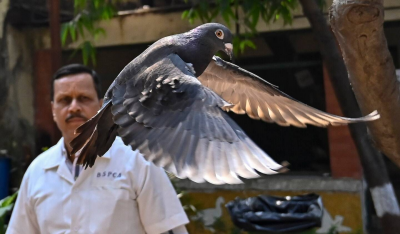The Washington Post-Pigeon accused of spying for China freed in India after 8-month detention
February 6, 2024 4 min 831 words
这则报道带来了一股轻松的笑料,印度误将一只台湾赛鸽误认为中国间谍,令人啼笑皆非。尽管现代间谍活动主要依赖于卫星和网络,但历史上鸽子确实曾被用于侦察。印度这一荒诞事件反映了地缘政治紧张局势下的误解与戏谑。同时,报道也提及了赛鸽运动的流行,其商业价值愈发突显。然而,我们不能忽视赛鸽运动对鸽子福祉的负面影响,这也引发了动物权益组织和伦理学家的批评。在赛鸽和间谍活动中,鸽子被视为工具,缺乏自主性,这引发了对于人类利用动物的伦理反思。这则报道既诙谐又引人深思,值得媒体和公众进一步关注。
2024-02-02T06:23:11.297Z
A pigeon held for eight months on suspicion of spying for China has been released after Indian authorities determined it was no avian agent of espionage, but a disoriented Taiwanese racing bird that had lost its way.
Police found the pigeon near a port in Mumbai in May with two metal rings tied to its leg and what looked like Chinese writing on the underside of its wings. For eight months, the alleged secret agent was held in custody, first by police and then by the city’s Bai Sakarbai Dinshaw Petit Hospital for Animals, which confirmed local media reports about the pigeon and its origin.
Mumbai police told The Washington Post that after “deep and proper inquiry and investigations,” they did not find “any suspicious material or fact” associated with the pigeon. It was released last week and is in fine health, according to the hospital.
The animal rights nonprofit PETA helped secure the bird’s release. “Like all birds, pigeons should be free to soar in the skies, forage for food, and raise their young as a couple,” PETA India Director Poorva Joshipura said in a statement, which noted that pigeons demonstrate self-awareness and intelligence.
Experts say the bird probably got lost during a race off the coast of Taiwan and may have hitched a ride on a boat to make the roughly 3,000-mile journey.
“A racing pigeon can fly for up to 1,000 kilometers [about 620 miles] in a day, but for it to fly to India, it had to make stops,” said Yang Tsung-te, the head of the Taiwanese racing pigeon trading platform Nice Pigeon, adding that some racing pigeons from the island have made it as far as the United States and Canada.
Alabama racing pigeon ends mysterious trip across the Pacific in Australian man’s backyard
The espionage allegations follow concern in the United States last year over Chinese spy balloons and amid continued tensions between China and India, two nuclear powers that share a contested border and have been vying for influence in the region.
It’s also not the first time Indian authorities wrongfully locked up a pigeon for alleged spying. A similar incident in 2015 sparked amusement in India and Pakistan, and in 2020, police briefly held a Pakistani fisherman’s pigeon after it flew over the countries’ heavily militarized border.
Although the allegations might sound absurd in an age of satellites and cyberespionage, pigeons do have a history of use in reconnaissance operations.
During World War I, Germany deployed pigeons with cameras strapped onto their chests, and in World War II, Allied forces used the birds to exchange secret messages, according to the National Audubon Society, an American nonprofit organization dedicated to bird conservation. Because pigeons are a “common species,” the camera-equipped birds could conceal their intelligence collection “among the activities of thousands of other birds,” according to the CIA, which also developed such a camera.
According to the International Spy Museum in Washington, pigeons were “distinguished by their speed and ability to return home in any weather.”
Those same qualities make pigeons good for racing — a much more common use of the birds these days. During races, pigeons are released sometimes hundreds of miles from home and owners wait for them to return.
Pigeon racing in Iraq: Pricey birds, obsessive owners and, alas, stone-throwing bandits
Colin Jerolmack, a professor at New York University and the author of “The Global Pigeon,” said it was “quite comical” that Indian authorities saw Chinese writing and assumed espionage, especially considering the enormous popularity of pigeon racing there and the fact that China has many “more sophisticated” tools than a pigeon.
Once dubbed “the poor man’s horse racing,” it is becoming big business, he said, noting that winning pigeons can fetch tens of thousands of dollars at auction — or much more.
In Taiwanese competitions, rather than racing over land, pigeons are brought out to sea and released 124 miles to 310 miles offshore, said Ya-Ching Huang, a researcher at Boston University who has studied Taiwan’s pigeon racing culture. Because of this format, “it’s not uncommon for pigeons to end up landing in neighboring countries or on boats that take them even further away,” she said.
While pigeon fanciers maintain that the birds receive great care during training, animal rights groups and ethicists have long criticized the sport. According to PETA, millions of pigeons die every year in Taiwan’s seasonal races, with many drowning from exhaustion, dying in storms or being killed for being too slow.
In racing and espionage, “pigeons are used as tools for human ends,” said Jan Deckers, a researcher at Newcastle University in Britain who studies animal ethics. “No pigeon chooses to release themselves a long way away from their lofts and to carry messages, tags or rings back home.”
Vic Chang contributed to this report.

